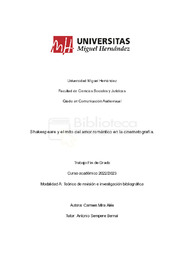Por favor, use este identificador para citar o enlazar este ítem:
https://hdl.handle.net/11000/30017Registro completo de metadatos
| Campo DC | Valor | Lengua/Idioma |
|---|---|---|
| dc.contributor.advisor | Sempere Bernal, Antonio | - |
| dc.contributor.author | Mira Alés, Carmen | - |
| dc.contributor.other | Departamentos de la UMH::Ciencias Sociales y Humanas | es_ES |
| dc.date.accessioned | 2023-11-06T11:17:31Z | - |
| dc.date.available | 2023-11-06T11:17:31Z | - |
| dc.date.created | 2023-06 | - |
| dc.identifier.uri | https://hdl.handle.net/11000/30017 | - |
| dc.description.abstract | El objetivo de este trabajo es exponer diversas facetas de Shakespeare que sin un previo análisis y documentación el lector y espectador no es capaz de ver, además de ver su influencia en la cinematografía desde sus inicios. Además, otro de los objetivos es llegar a ver como la obra de Romeo y Julieta surge por inspiración en otro autor y como la historia ha perdurado e influenciado, no solo en el cine, sino que también en las relaciones amorosas de hoy en día perpetuando, así, el mito del amor romántico y como la crítica cinematográfica y televisiva puede contribuir a desterrar estos mitos de nuestra sociedad. Por otro lado, se ha investigado sobre el mito del amor romántico y cómo se perpetúa estos mitos debido a la sociedad y como los medios audiovisuales son perpetuadores de esto. Para ello se ha leído y analizado diferentes textos de distinta índole para poder sacar las propias conclusiones sobre los diversos temas ilustrados en este trabajo. Por último, se ha pensado y dado soluciones educativas que parten de la educación de la crítica cinematográfica desde la infancia para el buen desarrollo de las relaciones. | es_ES |
| dc.description.abstract | The objective of this work is to expose sundry facets of Shakespeare that without prior analysis and documentation the reader and viewer are not able to see, in addition to seeing his influence on cinematography since its inception. In addition, another of the objectives is to get to see how the play of Romeo and Juliet arises from the inspiration of another author and how the story has endured an influenced, not only in the cinema, but also in today’s love relationships, enduring Thus, the myth of romantic love and how film and television criticism can help to banish these myths from our society. On the other hand, the myth of romantic love has been investigated and how these myths are perpetuated due to society and how the audiovisual media are perpetuators of this. For this, different texts of different kinds have been read and analyzed in order to draw their own conclusions on the various topics illustrated in this work. Finally, educational solutions have been thought and given that start from the education of film critics from childhood for the good development of relationships. | es_ES |
| dc.format | application/pdf | es_ES |
| dc.format.extent | 56 | es_ES |
| dc.language.iso | spa | es_ES |
| dc.publisher | Universidad Miguel Hernández de Elche | es_ES |
| dc.rights | info:eu-repo/semantics/openAccess | es_ES |
| dc.rights.uri | http://creativecommons.org/licenses/by-nc-nd/4.0/ | * |
| dc.subject | Shakespeare | es_ES |
| dc.subject | cinematografía | es_ES |
| dc.subject | mito amor romántico | es_ES |
| dc.subject.other | CDU::7 - Bellas artes::79 - Diversiones. Espectáculos. Cine. Teatro. Danza. Juegos.Deportes | es_ES |
| dc.title | Shakespeare y el mito del amor romántico en la cinematografía | es_ES |
| dc.type | info:eu-repo/semantics/bachelorThesis | es_ES |

Ver/Abrir:
ComunicaciónAudiovisual_TFG_Mira_Alés_Carmen.pdf
935,91 kB
Adobe PDF
Compartir:
 La licencia se describe como: Atribución-NonComercial-NoDerivada 4.0 Internacional.
La licencia se describe como: Atribución-NonComercial-NoDerivada 4.0 Internacional.
.png)